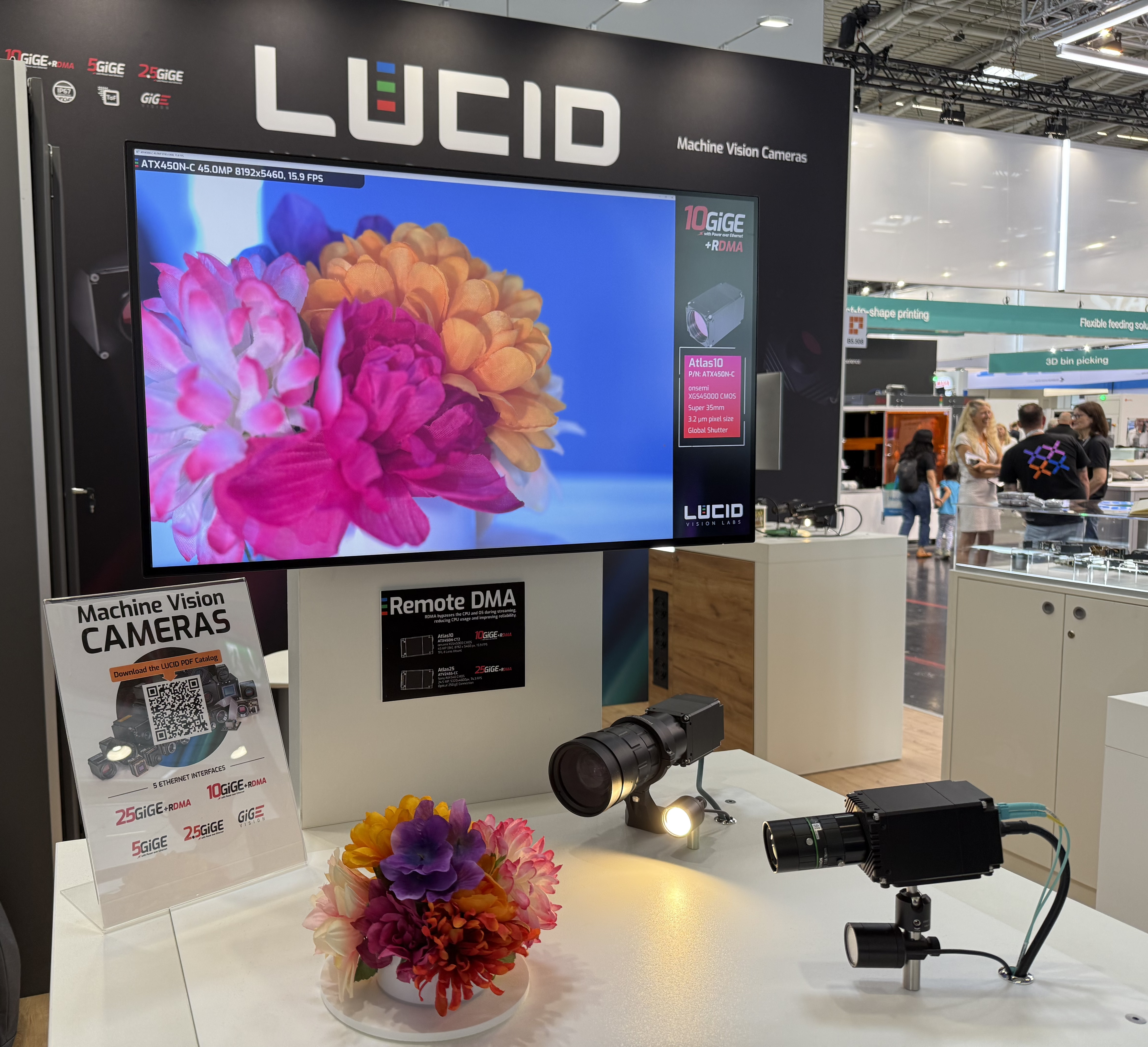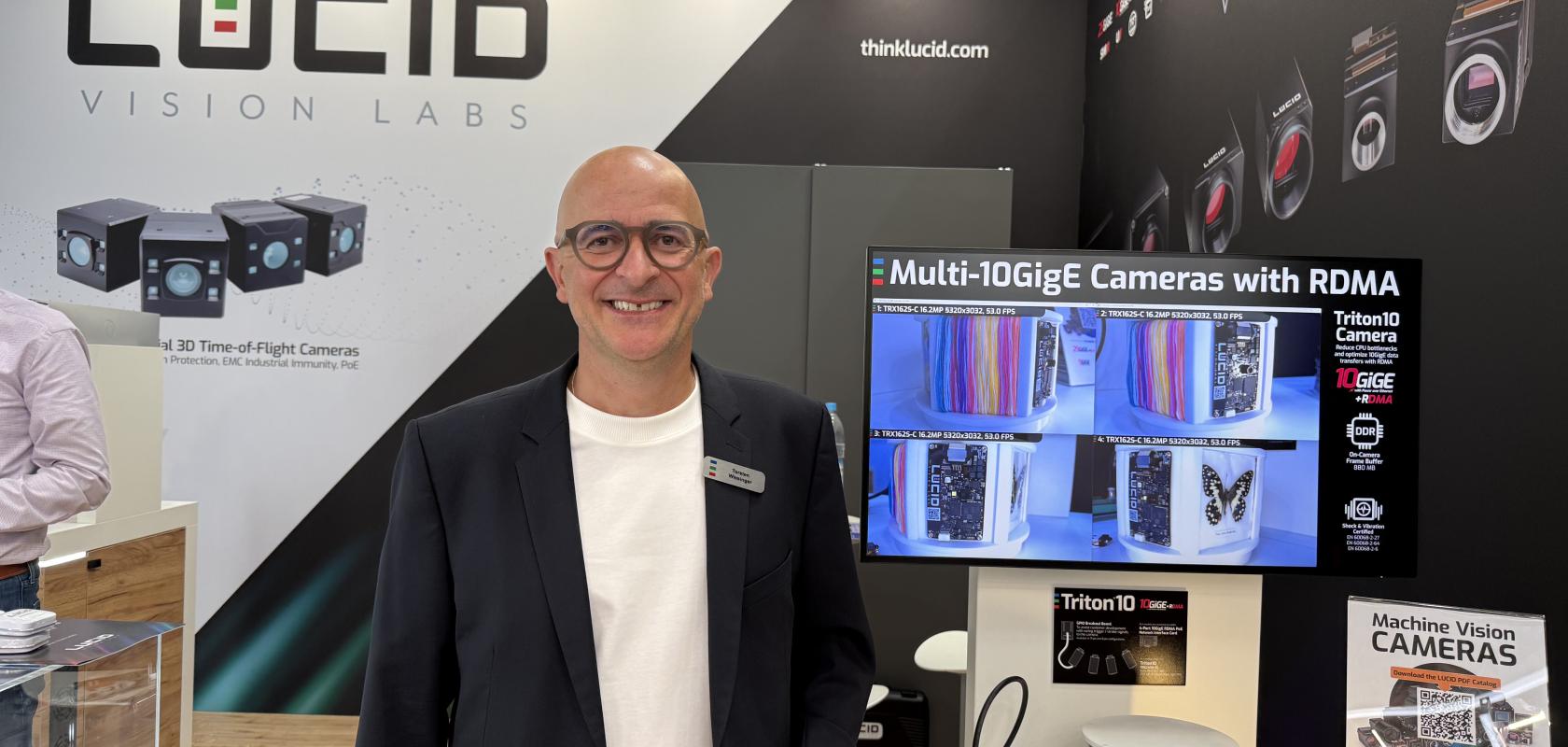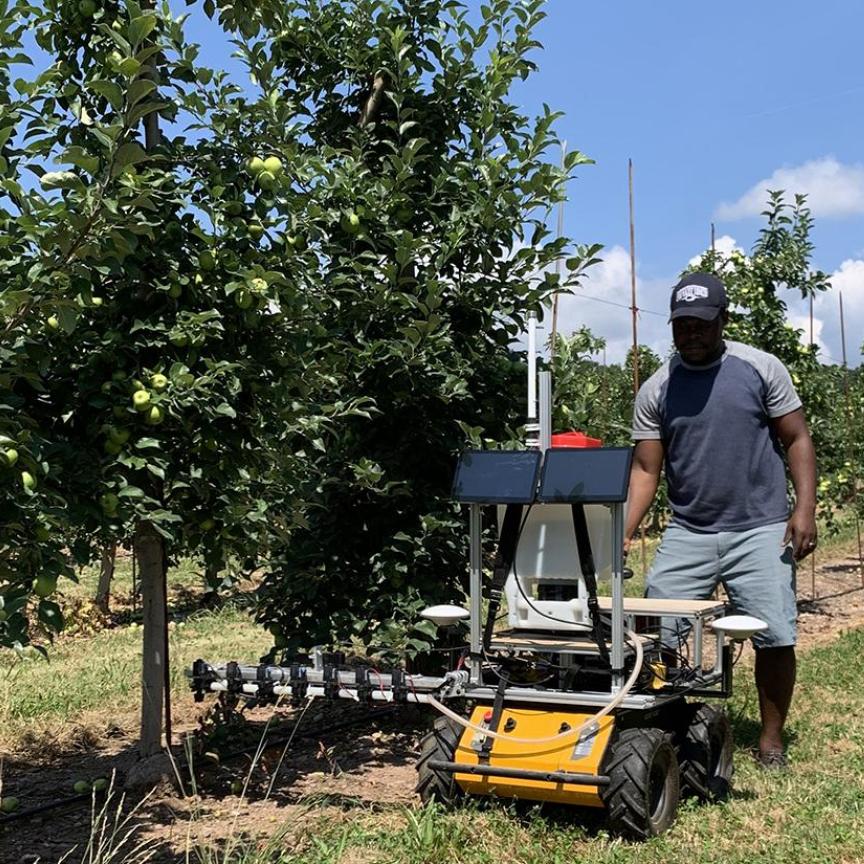LUCID Vision Labs – a Canadian company known for pushing boundaries in machine vision technology – is powering ahead with the momentum built from its successful reveal of two prototypes at last year’s Vision show. Its cutting-edge Triton10 GigE camera and RDMA network card marked a major milestone in high-speed, high-resolution imaging.
“We showed the concept last year – the technology and the prototypes,” said Torsten Wiesinger, General Manager of EMEA, who has been with the company since its early days almost a decade ago. “But now the Triton10 camera family is in production featuring a range of CMOS sensors from 5.0 MP to 24.5 MP – the same for our own developed and produced 4 port RDMA network card.”
Performance that turns heads
The Triton10 is nothing short of impressive. The multiple camera demo shown at Automatica featured a four-camera set-up, each capable of 16-megapixel resolution operating at a brisk 53 frames per second. All cameras run in perfect sync using PTP (Precision Time Protocol), with one acting as the master and the others as slaves. This setup runs on a single PC with virtually zero CPU load, thanks to LUCID’s 10GigE RDMA network card that minimises processor overhead.
While last year’s Vision event in Stuttgart, Germany, was an opportunity to gauge industry response to the new camera, the core design of the Triton10 has remained largely unchanged since. Some subtle but important enhancements were made, such as the addition of a new GPIO open connector and RS-422 protocol support to enable broader functionality, particularly for future line-scan sensor applications.
“We also launched our 4K line-scan camera as part of the Triton2 line,” Wiesinger adds, noting that demand for higher resolution is growing steadily. “Customers are asking for it, and we’re ready.”
In an industry where manufacturers often claim the smallest camera or the fastest frame rates, LUCID takes a different angle. “We might not have the smallest 10GigE camera,” Wiesinger acknowledges, “but we have the most flexible… Whether you need a TFL mount, huge sensors, or high-speed data capture, we can integrate it.”
This flexibility is crucial for industries that increasingly demand both high resolution and high speed – a combination that’s notoriously challenging to achieve. LUCID has invested heavily in sensor development and bandwidth optimisation to serve sectors that can't compromise on image quality or processing speed.
Who’s buying – and why?
While the Triton10 camera is designed with industrial applications in mind, its appeal spans a broad spectrum. Asked whether any particular markets have surprised the team with early interest, the answer is both cautious and pragmatic. “In this business, it’s always a bit unpredictable,” said Wiesinger. “One customer might be perfectly happy with VGA resolution at 30 fps, while the next insists on 24 megapixels at 50 fps. It’s all about specific needs.”

LUCID’s customer base ranges from traditional industrial automation to sectors such as agriculture, logistics, and broadcasting, all of which saw significant growth post-pandemic. The company has remained resilient even when traditional sectors such as automotive slowed down. “Our strength is that we’re not dependent on one single market or customer,” said Wiesinger. “That’s been one of our greatest achievements.”
A leap to 25 GigE – and fibre optics
While the Triton10 is the headline act for now, LUCID is already looking ahead. The next major release will be a 25 GigE camera, a step up from the current 10 GigE model, introducing fibre optic connections for the first time. “Fibre means much longer distances and greater flexibility,” said Wiesinger. “And it’s fully integrated – just slot in an SFP module, and you’re ready to go.”
This upgrade isn’t just about speed; it’s also about meeting the needs of expanding markets like broadcasting, which demand both bandwidth and reliability.
One of LUCID’s key differentiators is its ability to offer custom camera builds. This capability is rooted in the company’s history – the Phoenix camera, its first product launched (when the company formed) in 2017, was designed to support extensive customisation.
“Customers come to us asking for stereo cameras, dual sensors, or unique connectors,” said Wiesinger. “Sometimes they want a completely different housing, or even no lens mount at all. As long as the business case makes sense, we do it.”
AI, 3D, and the future of machine vision
No discussion about technology in 2025 is complete without a mention of AI. However, LUCID takes a grounded approach. While AI is transforming software, the company remains focused on delivering high-performance hardware that supports whatever algorithms customers need to run. “Everyone talks about AI, but many forget that you still need reliable hardware. Without it, none of the software matters,” said Wiesinger.
“We believe the future is in partnerships – hardware working seamlessly with AI-driven software.” LUCID recently introduced its new Triton Smart camera, equipped with Sony’s IMX501 intelligent vision sensor, providing a compact and cost-efficient solution that combines 12.3 MP high-quality imaging with on-sensor AI inferencing. This innovation reduces data bandwidth, latency, and the need for PC processing, making it perfect for object detection, automation, and vision-based decision making. The Triton Smart camera enhances system efficiency in logistics and manufacturing applications.
Another growing trend is 3D imaging. What was once a niche has now become a standard expectation in many industries, from inspection systems to robotics. “3D data improves precision and accuracy,” he says. “We’ve seen it growing steadily over the past decade, and it will only get bigger.”
LUCID has been at the forefront of 3D time-of-flight technology. The Helios2 3D ToF camera series is built for 24/7 operations in demanding industrial environments, excelling in applications such as robotics, 3D inspection, and logistics. These cameras offer versatile capabilities for advanced material handling, pick-and-place operations, sorting, palletisation/de-palletisation, and volume estimation. Equipped with Sony’s IMX556PLR Time-of-Flight (ToF) sensor and LUCID’s rugged IP67 Factory Tough design, the Helios2 cameras deliver high-accuracy 3D depth imaging with sub-millimeter precision, even in challenging warehouse conditions.
Listening first, then building
When asked what advice he’d give to new customers, Wiesinger’s answer is simple: come prepared but expect a conversation.
“Some customers know exactly what they need. Others don’t,” he explains. “That’s okay. Our job is to ask the right questions – about their environment, their objects, their precision needs – and guide them to the right solution.”
LUCID’s approach is consultative rather than transactional. It even has a dedicated team capable of reading code and helping with system integration, reflecting the company’s long-term commitment to its customers. “It’s easy to sell a camera once. The challenge is to support it for the long run,” said Wiesinger. “That’s how you build trust, and that’s how we’ve built this company.”


